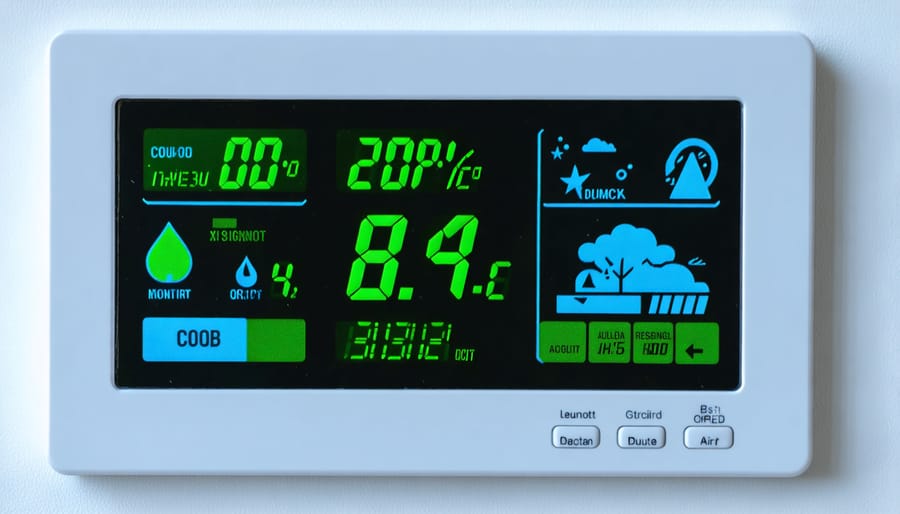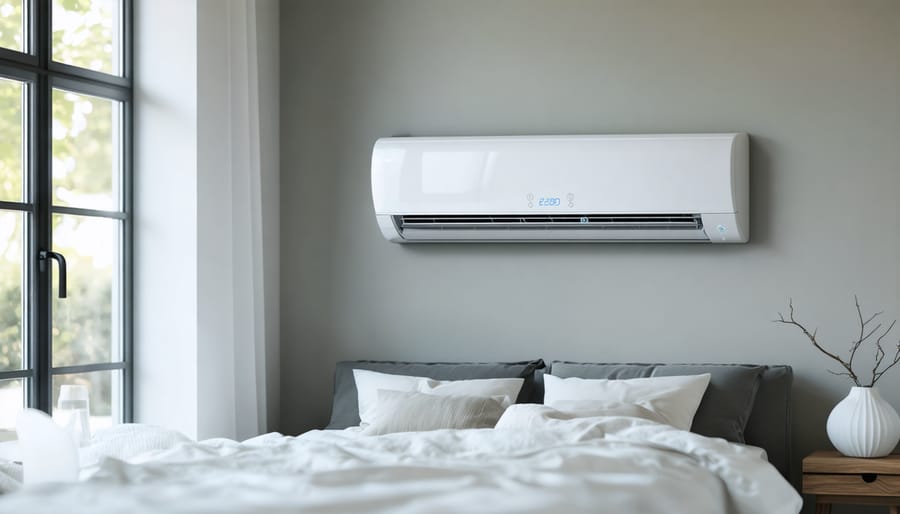Indoor CO2 levels significantly impact your daily well-being, affecting everything from cognitive function to sleep quality. Recent EPA studies reveal that Americans spend 90% of their time indoors, where CO2 concentrations can be 2-5 times higher than outdoor levels. Understanding and managing your indoor CO2 levels is crucial to boost your home’s air quality and protect your family’s health.
Think of CO2 as nature’s drowsiness signal – when levels rise above 1,000 parts per million (ppm), you might experience headaches, fatigue, and decreased concentration. In poorly ventilated homes, CO2 can easily exceed these levels, especially during winter months when windows remain closed. Modern energy-efficient buildings, while great for heating bills, can actually trap CO2 and other pollutants inside, creating an invisible but important air quality challenge.
The good news? You don’t need complex systems or expensive equipment to maintain healthy indoor CO2 levels. Simple awareness and regular monitoring can make a significant difference in your home’s air quality and your family’s well-being.
Why Indoor CO2 Levels Matter More Than You Think
The Science Behind Indoor CO2
Ever wonder why a room feels stuffy after a long meeting? It’s all about CO2 buildup, and the science behind it is pretty straightforward. When we breathe, we inhale oxygen and exhale carbon dioxide. In enclosed spaces like our homes and offices, this CO2 naturally accumulates over time, especially when multiple people are present.
The main sources of indoor CO2 are human breathing, pets, and some household activities like cooking with gas stoves. Think of your home as a container – without proper ventilation, the CO2 we exhale has nowhere to go. A single person at rest produces about 0.9 pounds of CO2 per day, and this number increases with physical activity.
What makes indoor CO2 levels rise so quickly? It’s simple physics. Carbon dioxide is slightly heavier than air, so it tends to concentrate in lower areas of rooms. Additionally, modern buildings are designed to be energy-efficient with better insulation and tighter seals, which is great for energy bills but can trap CO2 inside if we’re not careful about ventilation.

Health Effects of High CO2 Levels
High CO2 levels in your home can affect both your immediate comfort and long-term well-being. The most common symptoms you might experience include headaches, drowsiness, and difficulty concentrating – signs that many people mistakenly attribute to other causes. If you’ve ever felt unusually tired during a long meeting in a stuffy room, elevated CO2 levels might have been the culprit.
As CO2 levels rise above 1,000 parts per million (ppm), you may notice decreased cognitive performance and decision-making abilities. This can affect everything from your work productivity to your children’s learning capacity when studying at home. Some people also report feeling dizzy, experiencing slight nausea, or having trouble breathing deeply.
Long-term exposure to high CO2 levels can lead to more serious issues. Regular exposure above 2,000 ppm may contribute to respiratory problems, increased stress levels, and poor sleep quality. Children and elderly individuals are particularly sensitive to elevated CO2 levels, often showing symptoms at lower concentrations than healthy adults.
The good news is that these effects are typically reversible once CO2 levels are brought back to normal ranges. Being aware of these symptoms can help you identify potential air quality issues in your home before they become serious problems. Pay special attention if multiple family members experience similar symptoms that improve when they’re outdoors or in well-ventilated spaces.
Measuring CO2 in Your Home

Choosing the Right CO2 Monitor
When shopping for a CO2 monitor, focus on accuracy and reliability first. Look for monitors with NDIR (Non-Dispersive Infrared) sensor technology, as these provide the most accurate readings for home use. A good monitor should display readings in parts per million (ppm) and update measurements frequently.
Consider features like data logging and smartphone connectivity, which can help you track air quality trends over time. Some monitors also include temperature and humidity sensors, giving you a more complete picture of your indoor environment.
Budget-friendly options start around $100, while professional-grade monitors can cost $300 or more. For most homes, a mid-range monitor ($150-200) offers the right balance of accuracy and features.
Key features to look for:
– Display clarity and size
– Battery life or power options
– Calibration capabilities
– Measurement range (typically 0-5000 ppm)
– Portability if you plan to move it between rooms
Remember to place your monitor at breathing height and away from windows, doors, or direct airflow for the most accurate readings. Check reviews and warranty terms before making your final choice, as reliability can vary significantly between brands.
Ideal CO2 Levels for Different Rooms
Different rooms in your home have varying optimal CO2 levels based on their use and occupancy. In bedrooms, aim for 400-1,000 ppm for restful sleep, with anything above 1,000 ppm potentially affecting your sleep quality. Living rooms should maintain levels between 400-800 ppm during regular use, though they may temporarily rise during gatherings.
Home offices need special attention, as higher CO2 can impact concentration and productivity. Keep levels between 400-800 ppm for optimal mental performance. Kitchens might experience higher levels due to gas cooking, so target 400-1,000 ppm and ensure good ventilation while cooking.
For bathrooms, aim for 400-800 ppm, though brief spikes are normal. Children’s rooms and nurseries should maintain stricter levels between 400-800 ppm, as children are more sensitive to air quality changes. Basements often have higher CO2 levels, so target 400-1,000 ppm and use dehumidifiers if needed.
Remember, these ranges are guidelines, and your goal should be to keep levels as close to outdoor air (around 400 ppm) as possible while accounting for normal daily activities.
Simple Solutions for Better Air Quality
Natural Ventilation Strategies
Natural ventilation is one of the most cost-effective and environmentally friendly ways to improve your indoor air quality. The key is to create consistent air movement throughout your home, which helps flush out accumulated CO2 and bring in fresh outdoor air.
Start by implementing the simple yet effective strategy of cross ventilation. Open windows on opposite sides of your home to create a natural airflow path. This works best when there’s even a slight breeze outside. For multi-story homes, take advantage of the stack effect by opening windows on different floors – warm air naturally rises, creating an upward flow that pulls in fresh air from lower levels.
Make the most of your home’s design features. If you have a skylight, use it! Opening skylights along with ground-floor windows creates excellent vertical ventilation. Don’t forget about screen doors – they’re perfect for maintaining airflow while keeping insects out.
Time your ventilation strategically. Early morning and evening hours typically offer the best outdoor air quality and comfortable temperatures. During these periods, open multiple windows for about 15-20 minutes to perform an effective air exchange.
Consider these quick tips for maximizing natural ventilation:
– Position furniture to avoid blocking airflow paths
– Keep interior doors open when possible to promote air circulation
– Use window fans to enhance natural airflow
– Clean window screens regularly to maintain optimal air passage
– Install window locks that allow partial opening for nighttime ventilation
Remember that natural ventilation works best when combined with other air quality strategies, especially during extreme weather conditions when opening windows isn’t practical.
Mechanical Ventilation Options
When it comes to managing indoor CO2 levels, installing proper ventilation systems can make a world of difference. Let’s explore some effective mechanical ventilation options that can help you maintain healthier indoor air quality.
Heat Recovery Ventilators (HRVs) are fantastic options for year-round use. These systems work by exchanging stale indoor air with fresh outdoor air while preserving the temperature of your living space. During winter months, they transfer heat from the outgoing air to the incoming fresh air, helping maintain comfort and energy efficiency.
Energy Recovery Ventilators (ERVs) take things a step further by managing both heat and moisture transfer. They’re particularly useful in humid climates, as they help maintain comfortable humidity levels while providing fresh air exchange.
Exhaust fans are simpler but effective solutions, especially for bathrooms and kitchens where CO2 and other pollutants tend to accumulate. Modern exhaust fans often come with humidity sensors and timer functions, making them both convenient and efficient.
Whole-house ventilation systems offer a comprehensive solution by continuously exchanging air throughout your entire home. These systems can be integrated with your existing HVAC setup and often include filtration components to remove pollutants while bringing in fresh air.
For smaller spaces or specific rooms, window-mounted ventilators provide a budget-friendly option. These units can be programmed to exchange air at regular intervals and some even come with CO2 sensors that automatically adjust operation based on indoor air quality.
Remember, the key to successful mechanical ventilation is choosing a system that matches your specific needs, climate, and home size. Consider factors like maintenance requirements, energy efficiency, and noise levels when making your selection. Many homeowners find that a combination of different ventilation methods works best for their situation.
Smart Home Integration for Air Quality
Smart home technology has revolutionized how we monitor and control indoor air quality, making it easier than ever to maintain healthy CO2 levels. Modern smart CO2 monitors can seamlessly integrate with your home automation system, providing real-time data and automated responses to keep your indoor air fresh and clean.
Popular smart home platforms like Google Home, Amazon Alexa, and Apple HomeKit now support various CO2 monitors and air quality sensors. These devices can trigger automated responses when CO2 levels rise above recommended thresholds. For instance, your system can automatically activate ventilation fans, open smart windows, or adjust your maintain your air conditioning system to bring in fresh air.
Many smart CO2 monitors offer mobile apps that send real-time alerts to your phone when air quality deteriorates. You can check CO2 levels from anywhere and make adjustments remotely. Some advanced systems even learn your daily patterns and automatically adjust ventilation based on occupancy and activities.
For optimal results, consider setting up automation routines that coordinate multiple devices. Your CO2 monitor can work with smart thermostats, humidity sensors, and air purifiers to create a comprehensive air quality management system. You might program your system to increase ventilation during cooking hours or when hosting gatherings, ensuring CO2 levels stay within healthy ranges.
Installing a smart CO2 monitoring system doesn’t have to be complicated. Many modern sensors are wireless and battery-powered, making them easy to place anywhere in your home. They can typically be set up in minutes using your smartphone and home Wi-Fi network.

Maintaining Healthy CO2 Levels Long-Term
Maintaining healthy CO2 levels in your home isn’t a one-time fix – it requires ongoing attention and smart habits. The good news is that once you establish these routines, they become second nature and contribute to a healthier living environment.
Start by developing a regular ventilation schedule. Open windows for 5-10 minutes at least twice daily, ideally during morning and evening hours when outdoor air quality is typically better. During winter months, you can still ventilate efficiently by creating quick cross-ventilation without losing too much heat.
Make it a habit to check your ventilation systems monthly. Clean or replace HVAC filters regularly, and ensure that air vents aren’t blocked by furniture or curtains. If you have exhaust fans in your kitchen and bathrooms, use them consistently during cooking and showering to prevent CO2 buildup.
Consider incorporating natural air quality solutions like strategic plant placement throughout your home. While plants alone won’t solve CO2 issues, they contribute to overall air quality improvement when combined with other measures.
Set calendar reminders for quarterly maintenance checks of your ventilation equipment. This includes cleaning ductwork, checking mechanical ventilation systems, and ensuring that any CO2 monitors are working correctly. If you have a smart home system, program it to alert you when ventilation might be needed based on occupancy patterns.
Remember to adjust your ventilation strategy based on seasonal changes and occupancy levels. More frequent air exchanges may be necessary during gatherings or when more people are home for extended periods. By maintaining these practices consistently, you’ll create a healthier indoor environment for everyone in your home.
Maintaining healthy indoor CO2 levels is simpler than you might think, and the benefits to your health and well-being are significant. By regularly monitoring CO2 levels, ensuring proper ventilation, and implementing the suggested improvements we’ve discussed, you can create a healthier living environment for you and your family. Remember that even small changes, like opening windows more frequently or adding some air-purifying plants, can make a meaningful difference. Take action today by starting with one simple step – whether it’s purchasing a CO2 monitor or creating a ventilation schedule. Your lungs (and brain) will thank you for it! Keep in mind that good indoor air quality is an ongoing process, not a one-time fix, so make these practices part of your regular home maintenance routine.
